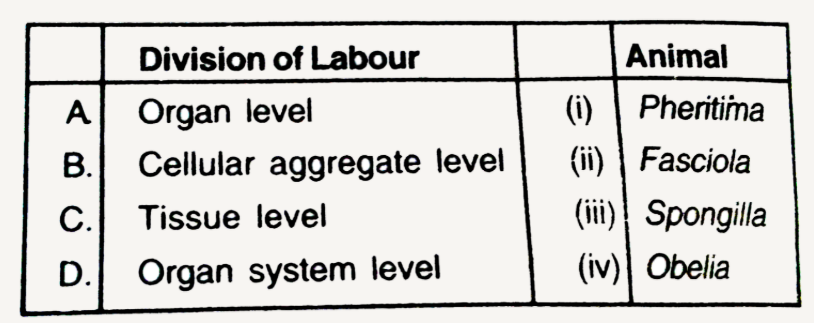Match the following list of animals with their level of organisation.
Division of LabourAnimalA.Organ leveli.PheretimaB.Cellular aggregate levelii.FasciolaC.Tissue leveliii.SpongillaD.Organ system leveliv.Obelia
Choose the correct match showing division of labour with animal example.
i-B,ii-C, iii-D and iv-A
i-B,ii-D, iii-C and iv-A
i-D,ii-A, iii-B and iv-C
i-A,ii-D, iii-C and iv-B
The correct Answer is:c
To solve the problem of matching the levels of organization with the respective animals, we can follow these steps:
1. Understand the Levels of Organization:
- Organ Level: This level involves the organization of tissues into organs that perform specific functions.
- Cellular Aggregate Level: This level is characterized by a collection of cells that work together but do not form true tissues.
- Tissue Level: This level involves the organization of similar cells into tissues that perform a specific function.
- Organ System Level: This level involves multiple organs working together to perform complex functions.
2. Identify the Animals:
- Pheretima: This is the scientific name for the earthworm, which belongs to the phylum Annelida.
- Fasciola: This is a liver fluke, which belongs to the phylum Platyhelminthes.
- Spongilla: This is a freshwater sponge, which belongs to the phylum Porifera.
- Obelia: This is a colonial organism belonging to the phylum Cnidaria.
3. Match Each Level of Organization with the Correct Animal:
- A. Organ Level: This is found in Fasciola (liver fluke) from the phylum Platyhelminthes.
- B. Cellular Aggregate Level: This is found in Spongilla (sponge) from the phylum Porifera.
- C. Tissue Level: This is found in Obelia (a colonial organism) from the phylum Cnidaria.
- D. Organ System Level: This is found in Pheretima (earthworm) from the phylum Annelida.
4. Final Matching:
- A. Organ Level → ii. Fasciola
- B. Cellular Aggregate Level → iii. Spongilla
- C. Tissue Level → iv. Obelia
- D. Organ System Level → i. Pheretima
Final Answer:
- A → ii (Fasciola)
- B → iii (Spongilla)
- C → iv (Obelia)
- D → i (Pheretima)
- Organ Level: This level involves the organization of tissues into organs that perform specific functions.
- Cellular Aggregate Level: This level is characterized by a collection of cells that work together but do not form true tissues.
- Tissue Level: This level involves the organization of similar cells into tissues that perform a specific function.
- Organ System Level: This level involves multiple organs working together to perform complex functions.
- Pheretima: This is the scientific name for the earthworm, which belongs to the phylum Annelida.
- Fasciola: This is a liver fluke, which belongs to the phylum Platyhelminthes.
- Spongilla: This is a freshwater sponge, which belongs to the phylum Porifera.
- Obelia: This is a colonial organism belonging to the phylum Cnidaria.
- A. Organ Level: This is found in Fasciola (liver fluke) from the phylum Platyhelminthes.
- B. Cellular Aggregate Level: This is found in Spongilla (sponge) from the phylum Porifera.
- C. Tissue Level: This is found in Obelia (a colonial organism) from the phylum Cnidaria.
- D. Organ System Level: This is found in Pheretima (earthworm) from the phylum Annelida.
- A. Organ Level → ii. Fasciola
- B. Cellular Aggregate Level → iii. Spongilla
- C. Tissue Level → iv. Obelia
- D. Organ System Level → i. Pheretima
- A → ii (Fasciola)
- B → iii (Spongilla)
- C → iv (Obelia)
- D → i (Pheretima)
Topper's Solved these Questions
- ANIMAL KINGDOMBook:NCERT FINGERTPS ENGLISHChapter:ANIMAL KINGDOMExercise:Assertion & Reason corner
Explore 15 Videos
- ANIMAL KINGDOMBook:NCERT FINGERTPS ENGLISHChapter:ANIMAL KINGDOMExercise:Animal Kingdom
Explore 148 Videos
- ANIMAL KINGDOMBook:NCERT FINGERTPS ENGLISHChapter:ANIMAL KINGDOMExercise:Hots
Explore 5 Videos
- ANATOMY OF FLOWERING PLANTSBook:NCERT FINGERTPS ENGLISHChapter:ANATOMY OF FLOWERING PLANTSExercise:Anatomy Of Flowering Plants
Explore 143 Videos
- BIOLOGICAL CLASSIFICATIONBook:NCERT FINGERTPS ENGLISHChapter:BIOLOGICAL CLASSIFICATIONExercise:Biological Classification
Explore 132 Videos
Similar Questions
Match the following list of animals with their level of organisation.
Choose the correct match sryowing division of labour with animal example.

View SolutionMatch the following list of animals with their level of organisation :

Choose the correct match showing division of labour with animals.
View Solution
Knowledge Check
Match the following list of bacteria and their commercially important products.
BacteriumProduct(i)Aspergillus niger(A)Lactic acid(ii)Acetobacter aceti(B)Butyric acid(iii)Clostridium butylicum(C)Acetic acid(iv)Lactobacillus(D)Citric acid
Choose the correct match.Ai−(B),ii−(C),iii−(D),iv−(A)Bi−(B),ii−(D),iii−(C),iv−(A)Ci−(D),ii−(C),iii−(B),iv−(A)Di−(D),ii−(A),iii−(C),−iv−(B)
In which of the following phylum all the animals are exclusively marine with organ system level of organisation?
View SolutionMatch the animals given in column A with their location in column B.
Column AColumn B(i)DodoA.Africa(ii)QuaggaB.Russia(iii)ThylacineC.Mauritius(iv)Stellar's sea cowD.Australia
Choose the correct match from the following.
View SolutionMatch the followings and choose correct option.
Group AGroup BA.Aleurone layer(ii)Without fertilisationB.Parthenocarpic fruit(ii)NutritionC.Ovule(iii)Double fertilisationD.Endosperm(iv)Seed
View SolutionMatch the following list of bacteria and their commercially important products.
BacteriumProduct(i)Aspergillus niger(A)Lactic acid(ii)Acetobacter aceti(B)Butyric acid(iii)Clostridium butylicum(C)Acetic acid(iv)Lactobacillus(D)Citric acid
Choose the correct match.
View SolutionMatch the animals given in column A with their location in column B.
Column AColumn B(i)DodoA.Africa(ii)QuaggaB.Russia(iii)ThylacineC.Mauritius(iv)Stellar's sea cowD.Australia
Choose the correct match from the following.
(a) i-A, ii-C, iii-B, iv-D
(b) i-D, ii-C, iii-A, iv-B
(c) i-C, ii-A, iii-B, iv-D
(d) i-C, ii-A, iii-D, iv-B
View SolutionMatch the following column I with column II and choose the correct combination.
ColumnIColumnII(a)Earthworm(i)Gizzard(b)Cockroach(ii)Caecum(c)Frog(iii)Clitellum(d)Rat(iv)Cloaca
View SolutionMatch the following and choose the correct answer
A.Touch(i)Nasal epitheliumB.Smell(ii)Foramen magnumC.Cranial nerves(iii)Sensory papilaeD.Medulla oblongata(iv)Peripheral nervous system
View Solution

